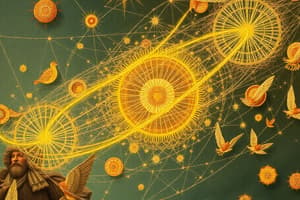Podcast
Questions and Answers
A neutral object experiences a shift in its charges, resulting in one side becoming positively charged and the opposite side becoming negatively charged. Which term best describes this phenomenon?
A neutral object experiences a shift in its charges, resulting in one side becoming positively charged and the opposite side becoming negatively charged. Which term best describes this phenomenon?
- Induction
- Polarization (correct)
- Conduction
- Compression
An object's velocity changes from 20 m/s to 30 m/s over a period of 5 seconds. What physical quantity is calculated using this information?
An object's velocity changes from 20 m/s to 30 m/s over a period of 5 seconds. What physical quantity is calculated using this information?
- Displacement
- Net Force
- Acceleration (correct)
- Speed
According to the laws of physics, which statement accurately describes the relationship between action and reaction?
According to the laws of physics, which statement accurately describes the relationship between action and reaction?
- Force is equal to mass times acceleration.
- For every action, there is an equal and opposite reaction. (correct)
- An object in motion stays in motion unless acted upon by an external force.
- Energy can neither be created nor destroyed, but it can be transferred from one form to another.
In the context of physics, what distinguishes velocity from speed?
In the context of physics, what distinguishes velocity from speed?
Which of the material properties listed best describes a material that resists the flow of electricity and heat?
Which of the material properties listed best describes a material that resists the flow of electricity and heat?
A book rests on a table. Which of the following forces is best described as 'compression'?
A book rests on a table. Which of the following forces is best described as 'compression'?
A car is traveling at a constant velocity. Suddenly, the driver slams on the brakes. What force is primarily responsible for opposing the car's motion and bringing it to a stop?
A car is traveling at a constant velocity. Suddenly, the driver slams on the brakes. What force is primarily responsible for opposing the car's motion and bringing it to a stop?
What is the kinetic energy of a 5 kg object moving at a velocity of 2 m/s?
What is the kinetic energy of a 5 kg object moving at a velocity of 2 m/s?
A 2 kg box is pushed with a force of 10 N. Assuming no friction, what is the acceleration of the box?
A 2 kg box is pushed with a force of 10 N. Assuming no friction, what is the acceleration of the box?
An object initially at rest accelerates at a constant rate of 3 m/s². What is its final velocity after 4 seconds?
An object initially at rest accelerates at a constant rate of 3 m/s². What is its final velocity after 4 seconds?
Flashcards
Motion
Motion
When an object's position changes as time passes.
Position
Position
Where something is located.
Displacement
Displacement
Change in an object's position from start to end.
Velocity
Velocity
Signup and view all the flashcards
Acceleration
Acceleration
Signup and view all the flashcards
Net Force
Net Force
Signup and view all the flashcards
Energy
Energy
Signup and view all the flashcards
Newton's 1st Law
Newton's 1st Law
Signup and view all the flashcards
Newton's 3rd Law
Newton's 3rd Law
Signup and view all the flashcards
Speed
Speed
Signup and view all the flashcards
Study Notes
Terminology
- Motion occurs when an object's position changes over time.
- Position is where something is located.
- Displacement is an object's change in position from start to end.
- Velocity is displacement over time, with speed and direction.
- Acceleration is the change in velocity divided by the change in time.
- Net Force is the sum of all forces acting on an object.
- Normal Force is compression.
- Energy is the ability to do work; work is the transfer of energy.
- Polarization occurs when charges in a neutral object shift, causing one side to be positive and one side negative.
- Force is a push or pull that changes motion, and F=ma.
- Conductor allows electricity and heat to flow through it (e.g., metal).
- Inductor is hard for electricity and heat to flow through it (e.g., glass, rubber, wood).
Newton's Laws
- Newton's 1st Law: An object at rest stays at rest; an object in motion stays in motion.
- Newton's 2nd Law: F=ma
- Newton's 3rd Law: For every action, there is an equal and opposite reaction.
Formulas
- Ff = M(Fn)
- Elastic Energy: ½ kv² (spring)
- Kinetic Energy: ½ mv² (movement)
- Net Force: F=ma
- Velocity: xf-xi/tf-ti
- Acceleration: vf-vi/tf-ti, measured in m/s²
- Area of a Triangle: ½ (bh)
- Area: ½ (b1+b2)h
- Speed: total distance/time
- Slope: rise/run
- Final Velocity: vi + at
Other Information
- Electrons are negatively charged.
- Protons are positively charged.
- "eg" represents height.
- "eth" represents friction.
- Eel represents electrical (Coulomb's Law).
- Pe represents potential energy when an object moves due to its position.
Force Laws
- Gravitational force pulls towards the Earth.
- Tension is the force in a rope or string.
- Electric forces attract opposites.
- Friction resists motion and depends on the surface type.
Studying That Suits You
Use AI to generate personalized quizzes and flashcards to suit your learning preferences.




